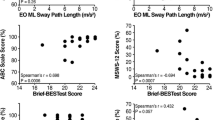Abstract
Multiple sclerosis (MS) patients often complain about balance problems when Romberg’s test and tandem gait are normal. The aim of the study was to determine if measures of trunk sway taken during a battery of stance and gait tasks could be used to detect subclinical balance disorders. We recorded trunk angular sway in the pitch and roll directions from 20 MS patients (EDSS 1.4 ± 0.5) and 20 age- and gender-matched healthy controls (HCs), during 12 stance and gait tasks. We filmed 22 subjects simultaneously. Two neurologists assessed the videos, deciding whether task performance was pathological. Sway measures were significantly different between patients and HCs in eight out of 12 balance tasks. The most significant differences between MS patients and HCs were pitch angle range standing on one leg with eyes open on a firm surface (mean 3.13° vs. 2.09°, p = 0.005), and on a foam support surface (mean 6.24° vs. 2.96°, p = 0.006), pitch velocity range walking 8 m with eyes closed (mean 75.5 vs. 50.2°/s, p < 0.001) and pitch velocity range walking 3 m on heels (mean 85.37 vs. 60.9°/s, p = 0.002). Multivariate analysis revealed a model with three tasks which detected balance disorders in 84% of the MS patients and 90% of the HCs correctly. The neurologists achieved accuracies of 30% for the MS patients and 82% for the HCs. Using trunk sway measures during stance and gait tasks is a sensitive screening method for balance problems in MS patients, and is more accurate than assessment by trained neurologists.


Similar content being viewed by others
References
Corradini ML, Fioretti S, Leo T, Piperno R (1997) Early recognition of postural disorders in multiple sclerosis through movement analysis: a modeling study. IEEE Trans Biomed Eng 44:1029–1038
Karst GM, Venema DM, Roehrs TG, Tyler AE (2005) Center of pressure measures during standing tasks in minimally impaired persons with multiple sclerosis. J Neurol Phys Ther 29:170–180
Gensicke H, Corporaal S, Kappos L, Allum J, Yaldizli Ö (2011) Correlations of balance instability and disability in multiple sclerosis patients [abstract]. J Neurol 258:P92
Soyuer F, Mirza M, Erkorkmaz U (2006) Balance performance in three forms of multiple sclerosis. Neurol Res 28:555–562
Cattaneo D, Cardini R (2001) Computerized system to improve voluntary control of balance in neurological patients. Cyberpsychol Behav 4:687–694
Cakt BD, Nacir B, Genc H, Saracoglu M, Karagoz A, Erdem HR et al (2010) Cycling progressive resistance training for people with multiple sclerosis: a randomized controlled study. Am J Phys Med Rehabil 89:446–457
Missaoui B, Thoumie P (2009) How far do patients with sensory ataxia benefit from so-called “proprioceptive rehabilitation”? Neurophysiol Clin 39:229–233
Widener GL, Allen DD, Gibson-Horn C (2009) Randomized clinical trial of balance-based torso weighting for improving upright mobility in people with multiple sclerosis. Neurorehabil Neural Repair 23:784–791
Polman CH, Reingold SC, Edan G, Filippi M, Hartung HP, Kappos L et al (2005) Diagnostic criteria for multiple sclerosis: 2005 revisions to the “McDonald Criteria”. Ann Neurol 58:840–846
Jacobson GP, Newman CW (1990) The development of the dizziness handicap inventory. Arch Otolaryngol Head Neck Surg 116:424–427
Cattaneo D, Jonsdottir J, Zocchi M, Regola A (2007) Effects of balance exercises on people with multiple sclerosis: a pilot study. Clin Rehabil 21:771–781
Cameron MH, Horak FB, Herndon RR, Bourdette D (2008) Imbalance in multiple sclerosis: a result of slowed spinal somatosensory conduction. Somatosens Mot Res 25:113–122
Martin CL, Phillips BA, Kilpatrick TJ, Butzkueven H, Tubridy N, McDonald E et al (2006) Gait and balance impairment in early multiple sclerosis in the absence of clinical disability. Mult Scler 12:620–628
Findling O, Sellner J, Meier N, Allum JH, Vibert D, Lienert C et al (2011) Trunk sway in mildly disabled multiple sclerosis patients with and without balance impairment. Exp Brain Res 213:363–370
Siva A, Saip S, Altintas A, Jacob A, Keegan BM, Kantarci OH (2009) Multiple sclerosis risk in radiologically uncovered asymptomatic possible inflammatory-demyelinating disease. Mult Scler 15:918–927
Hegeman J, Shapkova EY, Honegger F, Allum JH (2007) Effect of age and height on trunk sway during stance and gait. J Vestib Res 17:75–87
(1998) Randomised double-blind placebo-controlled study of interferon beta-1a in relapsing/remitting multiple sclerosis. PRISMS (Prevention of Relapses and Disability by Interferon beta-1a Subcutaneously in Multiple Sclerosis) Study Group. Lancet 352:1498–504
IFNB Multiple Scleriosis Study Group (2001) Interferon beta-lb is effective in relapsing-remitting multiple sclerosis. I. Clinical results of a multicenter, randomized, double-blind, placebo-controlled trial. 1993 [classical article]. Neurology 57:S3–S9
Jacobs LD, Cookfair DL, Rudick RA, Herndon RM, Richert JR, Salazar AM et al (1996) Intramuscular interferon beta-1a for disease progression in relapsing multiple sclerosis. The multiple sclerosis collaborative research group (MSCRG). Ann Neurol 39:285–294
Johnson KP, Brooks BR, Cohen JA, Ford CC, Goldstein J, Lisak RP et al (1995) Copolymer 1 reduces relapse rate and improves disability in relapsing-remitting multiple sclerosis: results of a phase III multicenter, double-blind placebo-controlled trial. The copolymer 1 multiple sclerosis study group. Neurology 45:1268–1276
Polman CH, O’Connor PW, Havrdova E, Hutchinson M, Kappos L, Miller DH et al (2006) A randomized, placebo-controlled trial of natalizumab for relapsing multiple sclerosis. N Engl J Med 354:899–910
Brandes DW, Shaya FT, Pill MW (2010) Quantifying the role of natalizumab in health and economic outcomes in multiple sclerosis. Am J Manag Care 16:S171–S177
Acknowledgments
MHJ Fanchamps was supported by a StudEx grant and Prof. JHJ Allum was supported by the National Swiss Research Foundation, grant No 32/117950.
Conflicts of interest
H Gensicke, L Kappos, J Kuhle and O Yaldizli have no conflicts of interests regarding this study. JHJ Allum worked as a consultant for the company supplying the equipment (SwayStar™) used in this study.
Author information
Authors and Affiliations
Corresponding author
Additional information
The authors M. H. J. Fanchamps and H. Gensicke contributed equally to this work.
Rights and permissions
About this article
Cite this article
Fanchamps, M.H.J., Gensicke, H., Kuhle, J. et al. Screening for balance disorders in mildly affected multiple sclerosis patients. J Neurol 259, 1413–1419 (2012). https://doi.org/10.1007/s00415-011-6366-5
Received:
Accepted:
Published:
Issue Date:
DOI: https://doi.org/10.1007/s00415-011-6366-5




